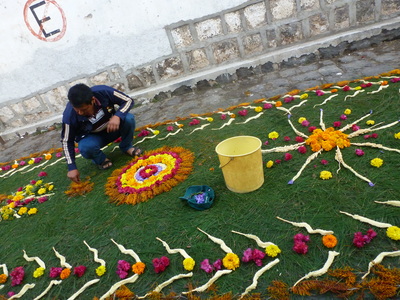These elaborate temporary carpets or alfombras, continuously line the route that the procession will take. In Guatemala these are called Aserrin de Alfombra, or “carpet of sawdust” or simply alfombras, to include the traditional alfombra which uses seeds, plants, and carefully separated parts from trees and flowers to create designs. These are constructed on Thursday or Friday of holy week and will pave the way for the processions. Though the lifespan of an alfombra is a matter of hours, they are the culmination of weeks and even months of creating new designs, carving stencils from cardboard, hand-dying sawdust to achieve the colors, collecting natural materials for alfombras and hours of communal labor before the procession. Each group pays for its own supplies and most begin collecting quetzals in February to cover the cost. The collaborators are family, neighbors, friends, or organizations, together focused on creating a work of art worthy of the divine.
Outside of Antigua, alfombras are created throughout Guatemala at this time and smaller andas are paraded by Catholic men and women over the beautifully arranged carpets of flowers, vegetables and fruit or of colored sawdust. As a resident of Lake Atitlán I had the honor of watching both my own pueblo, San Pedro La Laguna and the neighboring pueblo of San Juan La Laguna assemble their alfombras. For me the difference between the celebrations in Antigua and the ones I saw here were theatre and art. In Antigua much attention is given to the actual procession, where the passion story is depicted i detail each day due to it's extensive collection of andas which tell the story of Jesus's life in a collection of exquisitely crafted scenes telling Jesus's last week. Here at the lake, the celebration was the making of art, a creative offering, a collective undertaking, an offering and a celebration of creativity, community, and the joy and of making something divine with one another which would then again disappear in the way of the sacred cycle of life.















 RSS Feed
RSS Feed

